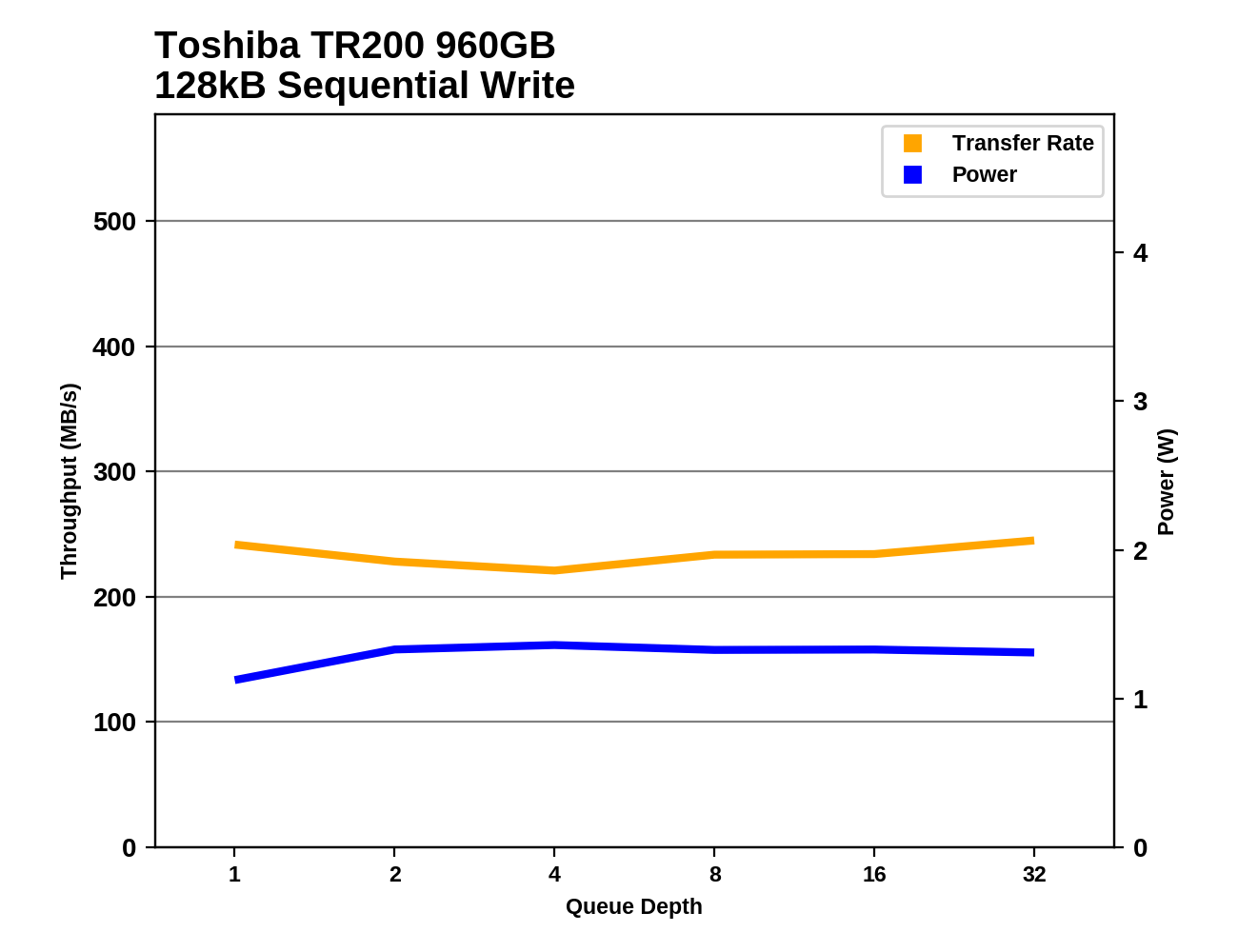The Toshiba TR200 3D NAND SSD Review: One Step Forward, One Step Back
by Billy Tallis on October 11, 2017 7:00 AM ESTSequential Read Performance
Our first test of sequential read performance uses short bursts of 128MB, issued as 128kB operations with no queuing. The test averages performance across eight bursts for a total of 1GB of data transferred from a drive containing 16GB of data. Between each burst the drive is given enough idle time to keep the overall duty cycle at 20%.

The burst sequential read performance of the TR200s is a significant improvement over the TR150 for the 240GB and 480GB models, but is a regression for the 960GB model. All of the TR200s are at the slow end of the chart, with the 480GB model lagging furthest behind its competitors.
Our test of sustained sequential reads uses queue depths from 1 to 32, with the performance and power scores computed as the average of QD1, QD2 and QD4. Each queue depth is tested for up to one minute or 32GB transferred, from a drive containing 64GB of data.

On the longer test of sequential reads, the larger two models of the TR200 perform quite similarly and are about average for a budget SSD. The 240GB is substantially slower, but still faster than all of the TR150 capacities and the 256GB ADATA SU800.

The power efficiency of the Toshiba TR200 is still above average, with the 240GB model in particular having a very good efficiency score. The HP S700 is not as efficient as the TR200 but is still reasonable, while the Crucial MX300 and ADATA SU800 score quite poorly on efficiency.
 |
|||||||||
Performance is nice and flat across queue depths, with the exception that the 240GB TR200 is a bit slower at QD1 than at higher queue depths. Most drives are faster, but at least there's nothing funny happening with the TR200.
Sequential Write Performance
Our test of sequential write burst performance is structured identically to the sequential read burst performance test save for the direction of the data transfer. Each burst writes 128MB as 128kB operations issued at QD1, for a total of 1GB of data written to a drive containing 16GB of data.

The burst sequential write performance of the TR200 is a significant improvement over the TR150, especially for the larger two capacities. They still have a bit further to go before catching up to the rest of the market: the TR/Trion series all stand out at the bottom of the chart.
Our test of sustained sequential writes is structured identically to our sustained sequential read test, save for the direction of the data transfers. Queue depths range from 1 to 32 and each queue depth is tested for up to one minute or 32GB, followed by up to one minute of idle time for the drive to cool off and perform garbage collection. The test is confined to a 64GB span of the drive.

On the longer sequential write test, the TR200s end up worse off than their predecessors, not better. The Trion/TR series drives are still all the slowest, and the 240GB manages barely more than a quarter the performance of the 256GB ADATA SU800.

All capacities of the TR200 are far more efficient at sequential writes than their predecessors. This is especially true for the 960GB model, which is more than twice as efficient as its TR150 counterpart. The smaller models are still scoring poorly on efficiency, but are no longer major outliers.
 |
|||||||||
The sequential write performance of the 960GB TR200 varies a bit over the course of the test, but not as much as several other budget drives. All of the TR200s are pretty much in a class of their own offering lower performance and very low power consumption of just over 1W.










50 Comments
View All Comments
lmcd - Thursday, October 12, 2017 - link
Isn't BX300 NVMe? Or is it SATA? 850 Evo might be the best "compatibility" option if the former.mapesdhs - Friday, October 13, 2017 - link
Curiously though, the 850 EVO still has a very good reputation. But for the price, it would be my default recommendation.sonny73n - Saturday, October 14, 2017 - link
All three are SATA3.takeshi7 - Wednesday, October 11, 2017 - link
Anandtech reviewed the Crucial BX300 and it seems very good.Samus - Wednesday, October 11, 2017 - link
BX300 is the only competitive drive at the moment (mostly on price) but older MX200’s can occasionally be found cheap and they have the capacity advantage.sonny73n - Thursday, October 12, 2017 - link
Are you capable of using the search function on AT?Ratman6161 - Thursday, October 12, 2017 - link
Seriously dude, your mom densest want an SSD for Christmas.HollyDOL - Wednesday, October 11, 2017 - link
Hm, with given price the performance is really poor... Unless you absolutely need to cut power requirements down in mW scale for some reason, I can't imagine it being a good choice.Valantar - Wednesday, October 11, 2017 - link
If this does indeed signal the beginning of the end of the NAND shortage, that is more than welcome. If that happens, I also hope we see significant reductions below MSRP for this over time, to the tune of i being noticeably cheaper than DRAM-equipped drives. In the next year, I want cheap 250-500GB SSDs for my XBONE and PS4, and DRAM-less drives should fit that bill nicely (the USB interface will limit them already, so I don't see the value of springing for anything above bargain-basement as long as it significantly outperforms an HDD).nathanddrews - Wednesday, October 11, 2017 - link
With 100GB games already shipping, will 250-500GB cut it anymore?